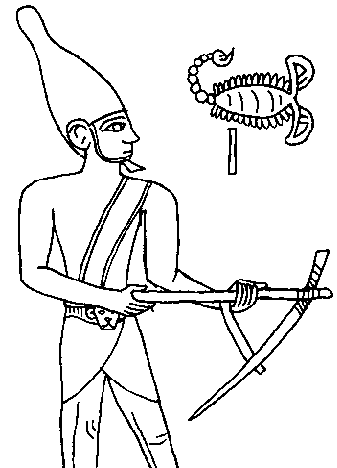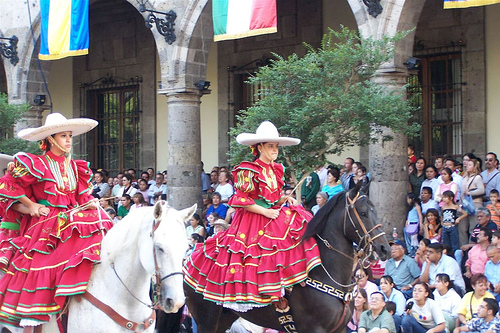
The Scorpion Macehead is an Ancient Egyptian ceremonial stone macehead. Ceremonial mace-heads are oversized versions of the small stone weapons that were typical grave goods during Egypt’s Predynastic Period.
In Ancient Egypt, the mace was the symbolic weapon of Predynastic Egypt. However, this ceremonial macehead’s function had evolved with their culture. Their size and decoration suggest that they had ritual significance, rather than a practical function.
The maceheads had become symbols of the Egyptian elite by about 3100 BC. Their surfaces were carved with imagery associated with the institution of kingship.
The scenes on the fragments of this Macehead depict King Scorpion performing the ceremonial opening of an irrigation canal.
It is attributed to the Pharaoh Scorpion (c. 3200–3000 BCE) due to the glyph of a scorpion engraved close to the image of a king wearing the White Crown of Upper Egypt.
An Egyptian glyph is the unique markings that collectively specify the meaning. In this case, Scorpion II, who was a ruler during the Protodynastic Period of Upper Egypt (c. 3200–3000 BC).
On the Macehead, the king is standing by a body of water and is followed by two fan bearers. A scorpion and a rosette are depicted close to his head.

King Scorpion’s Macehead – Ashmolean Museum
He is facing a man holding a basket and men holding standards. Several men are busy along the banks of the canal.
In the rear of the king’s retinue are some plants, a group of women clapping their hands, and some people, all of them facing away from the king.
Attended by fan-bearers, the king wears a ceremonial bull’s tail. Standing before him, a man holding a basket, and another carrying a broom, wait to collect the earth removed by the king’s hoe.
In Ancient Egyptian depictions, perspective was not used; instead, depth was depicted by a more remote scene above a closer one.
People’s lower body, legs, arms, and head were almost always shown in profile, while their torso was depicted in frontal view, as was the eye.
Legs are always apart. The size of the figure was often dependent on status; the king is depicted larger than their inferiors.
The Scorpion macehead was found by British archeologists in the Temple of Horus at Hierakonpolis during the dig season of 1897–1898. The Macehead measures 25 centimeters long, and it is made of limestone in a pear-shape.

Drawing of Scorpion II from the Scorpion Macehead
King Scorpion
Scorpion II, also known as King Scorpion, was a ruler during the Protodynastic Period of Upper Egypt (c. 3200–3000 BC).
The only pictorial evidence of his existence is the Scorpion Macehead. The stratigraphy of this Macehead was lost due to the methods of its excavators. But its style seems to date this macehead to the very end of the Predynastic Period.
The Scorpion Macehead depicts a single, large figure wearing the White Crown of Upper Egypt. He holds a hoe, which has been interpreted as a ritual.
Scorpion II may have been the founder of Nekhen or Buto, which would explain why the Macehead was found in Hierakonpolis.
King Scorpion may have been the immediate predecessor of King Narmer. He would therefore belong to the group of rulers preceding the kings of the historic 1st Dynasty.

Details of the fragments of Scorpion Macehead at the time of discovery in Hierakonpolis
Scorpion Macehead
- Artifact: Scorpion Macehead
- Also: Major Scorpion Macehead
- Date: Pharaoh Scorpion (c. 3200–3000 BCE)
- Material: Limestone
- Discovered: 1898, Temple of Horus at Hierakonpolis
- Dimensions: 25 centimeters long
- Category: Ancient Artifact, Ancient Egyptian
- Museum: Ashmolean Museum of Art and Archaeology
The Scorpion King and the Birth of Egypt
The Real Scorpion King – Scorpion I of Egypt
A Virtual Tour of Important Historical Artifacts
- Prehistoric Stone Hand Axe – 2.6 Million Years Ago
- Perforated Baton with low relief Horse – 40,000 Years Ago
- Venus of Brassempouy – 25,000 years ago
- Wolverine Pendant of Les Eyzies – 12,500 Years Ago
- Ain Sakhri Lovers – 11,000 Years Ago
- Prehistoric Deer Skull Headdress – 11,000 Years Ago
- Scorpion Macehead – 3200–3000 BC
- Narmer Palette – 3,100 BC
- Narmer Macehead – 3,100 BC
- The Stargazer (Statuette of a Woman) – 3000 BC
- Neolithic Painted Pottery – 2,500 BC
- Dancing Girl (Mohenjo-Daro) – 2,500 BC
- Li – Chinese Tripod Jar – 2,300 BC
- Treasure from Troy – 2,200 BC
- Bronze Age Gold Lunula – 2,200 BC
- Gudea, Prince of Lagash – 2,120 BC
- Law Code of Hammurabi – 1,750 BC
- Nebra Sky Disk – 1600 BC
- Mask of Agamemnon – 1,500 BC
- The Sphinx of Hatshepsut – 1,470 BC
- Tutankhamun’s Mask – 1,323 BC
- Mummy of Katebet – 1,300 BC
- Book of the Dead – Papyrus of Ani and Hunefe – 1,250 BC
- Avanton Gold Cone – 1,250 BC
- Bronze Age Shield Yetholm-type -1,200 BC
- Relief of a Winged Genie – 880 BC
- Siloam Inscription – 700 BC
- The Lion Hunt – 640 BC
- Ishtar Gate – 575 BC
- The Curse of the Tabnit Sarcophagus – 500 BC
- Kleroterion – 470 BC
- The Parthenon Marbles – 440 BC
- The Alexander Sarcophagus – 300 BC
- The Winged Victory of Samothrace – 200 BC
- The Rosetta Stone – 196 BC
- The Pergamon Altar – 150 BC
- Antikythera Mechanism – 100 BC
- Battersea Shield – 50 BC
- The Temple of Dendur – 10 A.D.
- James Ossuary – 1st-century
- Lindow Man – 2 BC and 119 AD
Ancient Egypt – The First Pharaohs
Scorpion Macehead
Virtual Tour of Ashmolean Museum of Art and Archaeology
- The Alfred Jewel
- The Messiah Stradivarius
- Arab ceremonial dress owned by Lawrence of Arabia
- Narmer Macehead – Ceremonial Weapon of Ancient Egypt
- The Macehead of King Scorpion
- Sumerian King List
~~~
“People bring about their own undoing through their tongues.”
– Egyptian Proverb
~~~
Photo Credit: akhenatenator / CC0 ; Udimu / CC BY-SA (creativecommons.org/licenses/by-sa/3.0); Benutzer:Weneg / CC BY-SA 3.0 DE (creativecommons.org/licenses/by-sa/3.0/de/deed.en) ; Quibell, James Edward, 1867-1935; Green, F. W; Petrie, W. M. Flinders (William Matthew Flinders), Sir, 1853-1942 / Public domain
Popular this Week








 Sponsor your Favorite Page
Sponsor your Favorite Page SEARCH Search for: Search Follow UsJoin – The JOM Membership Program
Sponsor a Masterpiece with YOUR NAME CHOICE for $5
Share this:
- Tweet
